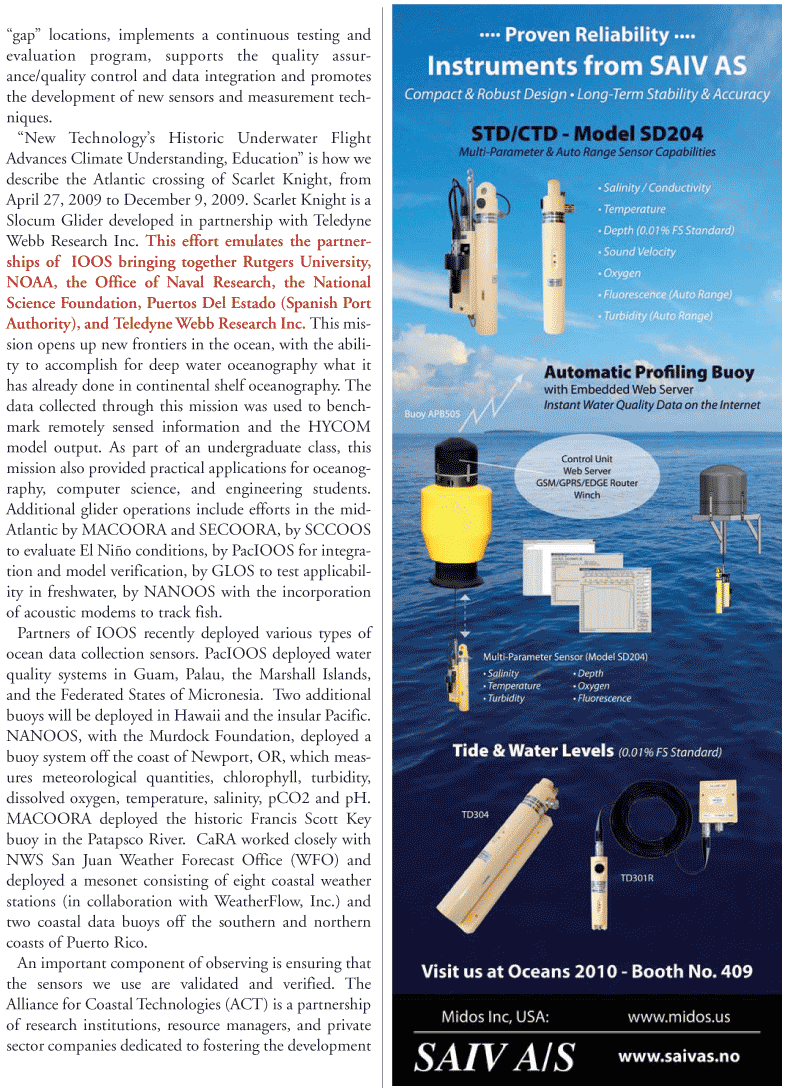
Page 27: of Marine Technology Magazine (September 2010)
Ocean Observation
Read this page in Pdf, Flash or Html5 edition of September 2010 Marine Technology Magazine
“gap” locations, implements a continuous testing and evaluation program, supports the quality assur- ance/quality control and data integration and promotes the development of new sensors and measurement tech- niques. “New Technology’s Historic Underwater Flight
Advances Climate Understanding, Education” is how we describe the Atlantic crossing of Scarlet Knight, from
April 27, 2009 to December 9, 2009. Scarlet Knight is a
Slocum Glider developed in partnership with Teledyne
Webb Research Inc. This effort emulates the partner- ships of IOOS bringing together Rutgers University,
NOAA, the Office of Naval Research, the National
Science Foundation, Puertos Del Estado (Spanish Port
Authority), and Teledyne Webb Research Inc. This mis- sion opens up new frontiers in the ocean, with the abili- ty to accomplish for deep water oceanography what it has already done in continental shelf oceanography. The data collected through this mission was used to bench- mark remotely sensed information and the HYCOM model output. As part of an undergraduate class, this mission also provided practical applications for oceanog- raphy, computer science, and engineering students.
Additional glider operations include efforts in the mid-
Atlantic by MACOORA and SECOORA, by SCCOOS to evaluate El Niño conditions, by PacIOOS for integra- tion and model verification, by GLOS to test applicabil- ity in freshwater, by NANOOS with the incorporation of acoustic modems to track fish.
Partners of IOOS recently deployed various types of ocean data collection sensors. PacIOOS deployed water quality systems in Guam, Palau, the Marshall Islands, and the Federated States of Micronesia. Two additional buoys will be deployed in Hawaii and the insular Pacific.
NANOOS, with the Murdock Foundation, deployed a buoy system off the coast of Newport, OR, which meas- ures meteorological quantities, chlorophyll, turbidity, dissolved oxygen, temperature, salinity, pCO2 and pH.
MACOORA deployed the historic Francis Scott Key buoy in the Patapsco River. CaRA worked closely with
NWS San Juan Weather Forecast Office (WFO) and deployed a mesonet consisting of eight coastal weather stations (in collaboration with WeatherFlow, Inc.) and two coastal data buoys off the southern and northern coasts of Puerto Rico.
An important component of observing is ensuring that the sensors we use are validated and verified. The
Alliance for Coastal Technologies (ACT) is a partnership of research institutions, resource managers, and private sector companies dedicated to fostering the development

 26
26

 28
28
